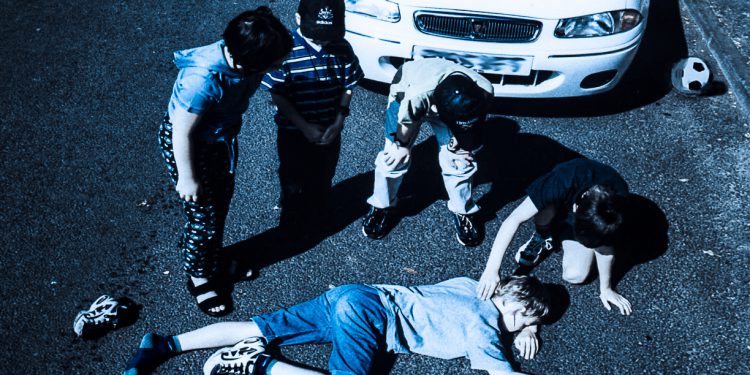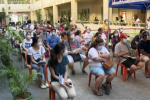10,000 Kids Get Road Education From Volkswagen

My 16-year-old son Robbie called me the other month. In an excited tone, he tells me he has began his driver education and may soon get his drivers license “Learners Permit.” Yes, my son is in the United States, Las Vegas to be exact, and yes they begin handing student drivers permit there at the early age of 15 years old.
What surprised me, when my son was telling me his story, was that their driver education course focused so much more on the laws, rules, road signs and intimate details of interacting with other motorists along the road than on learning to operate the machine.
“Dad, they make us read so many books on driving rules, I can’t wait to do actual driving,” Robbie says.
Granted that the US still has a high number of road crash fatalities, an average of 102 deaths per day in 2016, US Highway authorities have been very busy working to decrease this number. The biggest part of their effort is child education.
That is something sorely lacking in our educational system. Here where the daily average is 34 deaths, a solid 30% of the US total when our highway network is less than 20% compared to the United States.

At the 46th activation of Volkswagen Philippines’ Child Safety Initiative last Nov. 4 and 5 at Ayala Malls the 30th, Sabine Consunji (2nd from right) became the 10,000th kid to participate in the German marque’s award-winning CSR effort on road safety. To mark this momentous occasion, Sabine posed with her parents; Volkswagen mascot Wolfi; and, former Land Transportation Office Chief and now Philippine Global Road Safety Partnership Secretary General Alberto Suansing (left). (photo from Volkswagen)
There is hope though! Volkswagen Philippines has already educated a total of 10,000 kids from their Child Safety Initiative (CSI) CSR program which began in April of 2015.
The project has now logged 10,000 child participants and 7,289 parent observers nationwide. The Child Safety Initiative (CSI) is aimed at educating children about road safety including motor vehicle and pedestrian safe habits.
It has garnered four citations, including the Silver Award from Anvil, Gold Award from the Society of Philippine Motoring Journalists’ Driven to Serve and Stig Awards from Top Gear Philippines (for two consecutive years).
The CSI emphasizes the timeliness and urgency of pedestrian and motorist safety efforts. According to figures released by the Philippine Statistics Office in May 2017, an average of 34 Filipinos are killed every day in road accidents, and that the main cause of deaths among Filipino youths aged 15 to 19 are road accidents. It also revealed that transport-related crashes increased sharply from 15,572 in 2014 to 24,565 in 2016.

Teaching kids how to behave properly on the road may save them from road mishaps in the future. (photo from MMDA)
Data from Safe Kids Worldwide Philippines (SKWP) revealed that globally, an estimated 1.25 million people are killed and over 50 million are injured in road crashes annually, and that by 2020, road traffic crashes are expected to increase by 80 percent in low- and middle-income countries due to increasing motorization.
The CSI campaign is aimed at introducing early childhood safety awareness to children of 4 to 8 years of age with the Junior Driving Course module, while imparting important road safety habits to their parents. The Steps to Safety program (launched in April 2017 also during the MIAS), on the other hand, addresses the pedestrian safety for older children aged 9 to 12 years old, and for the graduates of the Junior Driving Course.
The Junior Driving Course features a miniature simulated roadway within a community (complete with road signages, stoplights, and miniature vehicles) for the kids’ use as well as the Child Seat Corner that emphasizes the passive safety devices of modern day passenger vehicles, with special focus on the use of age-appropriate child safety seats. It also draws in kids and their parents with a video show, primer, and coloring book activity.
Graduates of the Junior Driving Course receive their Junior Driver’s License, while participants who pass the Steps to Safety program get their road safety badge. More than receiving their licenses and badges, these kids and their parents have hopefully removed themselves from being potentially part of the tragic statistics of road accidents.
The Steps to Safety program uses the virtual reality (VR) and smartphone app technologies played on a Samsung Gear VR to attract participants, while a pedestrian road safety seminar, a pre-requisite to the experience of the VR app, teaches participants to become responsible adult road users.
The pedestrian road safety seminar, conducted by an instructor from the Philippine Global Road Safety Partnership, consists of lessons on how to cross roads safely, how to recognize traffic lights and signals, recognizing and following road signs and markings, and identifying the types of pedestrian crossings. The VR and smartphone app simulates a busy road network, wherein participants are required to pass all seven game levels by using pedestrian crossings, overpasses and following road signs.
Now, if only our public and private schools could start them out this early, then maybe we can hope. Maybe instead of teaching our children to memorize the history books of Agoncillo and Zayde or read those defective public school materials, they could hook up with Volkswagen and send the kids some real and useful education.






